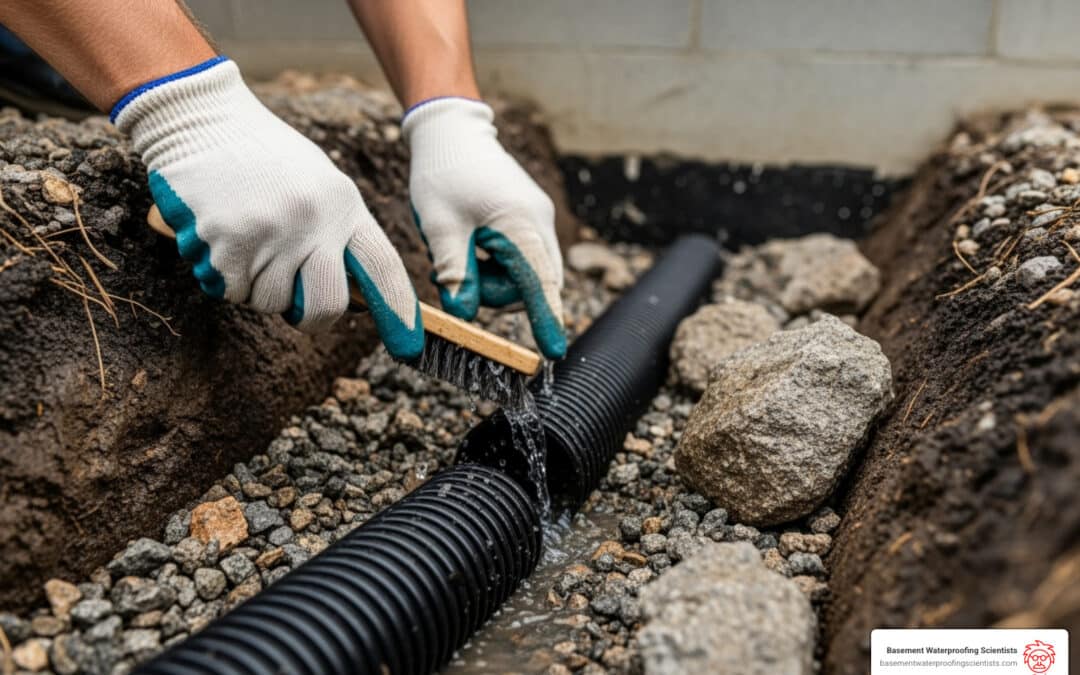Your First Line of Defense Against a Wet Basement
Cleaning out weeping tiles is a critical maintenance task for keeping your basement dry, yet many homeowners are unaware these systems exist until water appears in their basement.
Quick Answer for Cleaning Out Weeping Tiles:
- Test the system – Run water near your foundation and check if your sump pump activates.
- Simple cleaning – Use soapy water and a plunger through a basement floor drain.
- Let it work – Allow soapy water to sit for 30 minutes to break down debris.
- Rinse thoroughly – Flush with clean water and repeat if needed.
- Call professionals – For severe clogs, root intrusion, or if DIY methods fail.
Despite their name, weeping tiles aren’t tiles. They’re porous 4-inch pipes that collect groundwater around your foundation and direct it away. The term is a holdover from the 1800s when these drainage systems were made from terracotta tiles, a concept pioneered by Henry Flagg French.
Modern weeping tiles are plastic pipes with small holes that allow water to enter. As groundwater rises, it flows into these holes and is carried to a storm drain or your sump pump. This process relieves hydrostatic pressure that would otherwise push water through your foundation.
When weeping tiles clog with soil, roots, or debris, that pressure builds again, forcing water into your basement through cracks and joints. Symptoms of a drainage problem can be elusive. You might only notice puddles during rainstorms, or issues may develop slowly, going undetected for years until a foundation crack appears.
I’m Darin Garvey, and with over 30 years of experience helping Philadelphia-area homeowners solve basement water problems, I’ve seen how regular maintenance of these drainage systems can prevent thousands of dollars in water damage repairs.
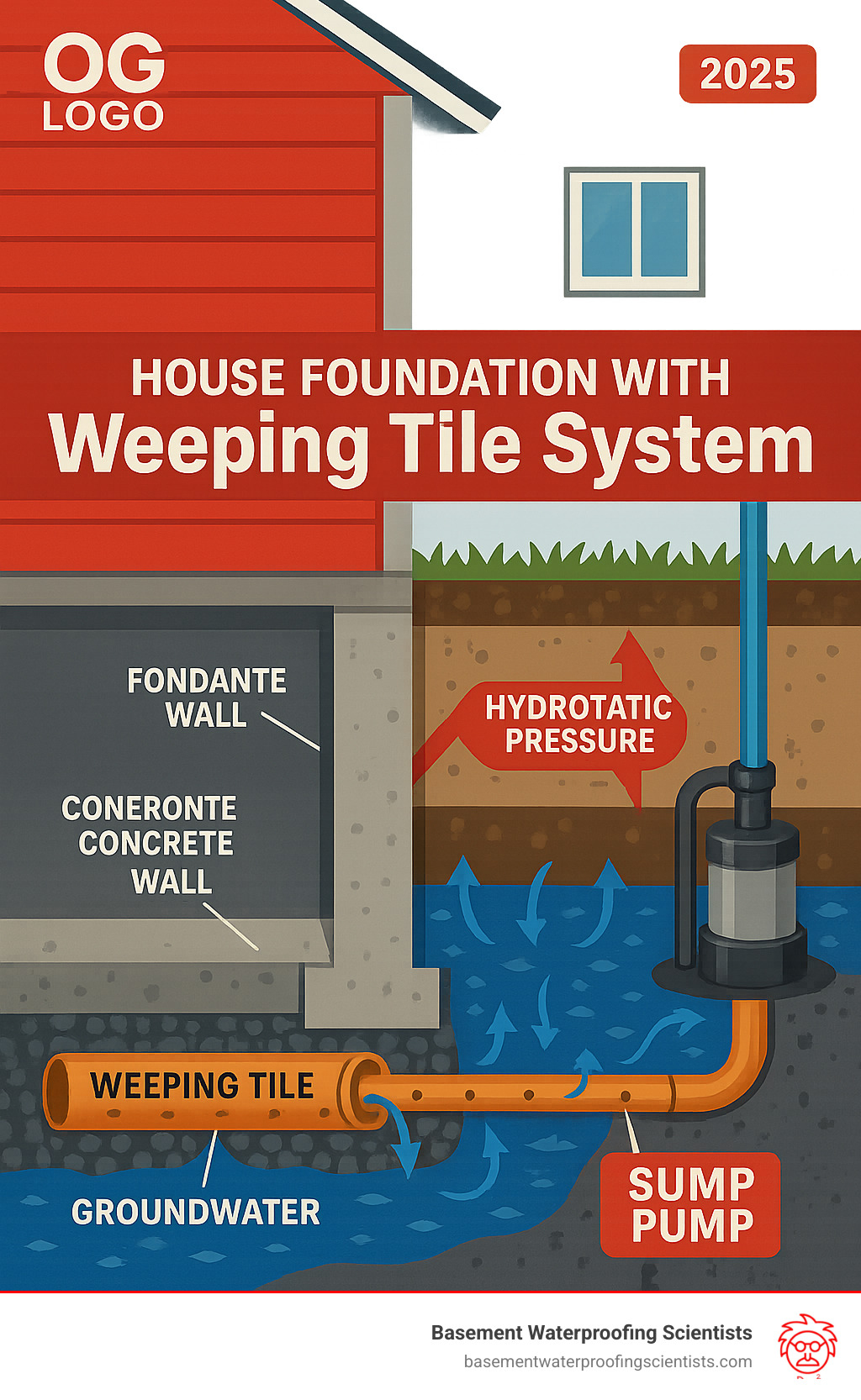
Are Your Weeping Tiles Clogged? Telltale Signs and Common Causes
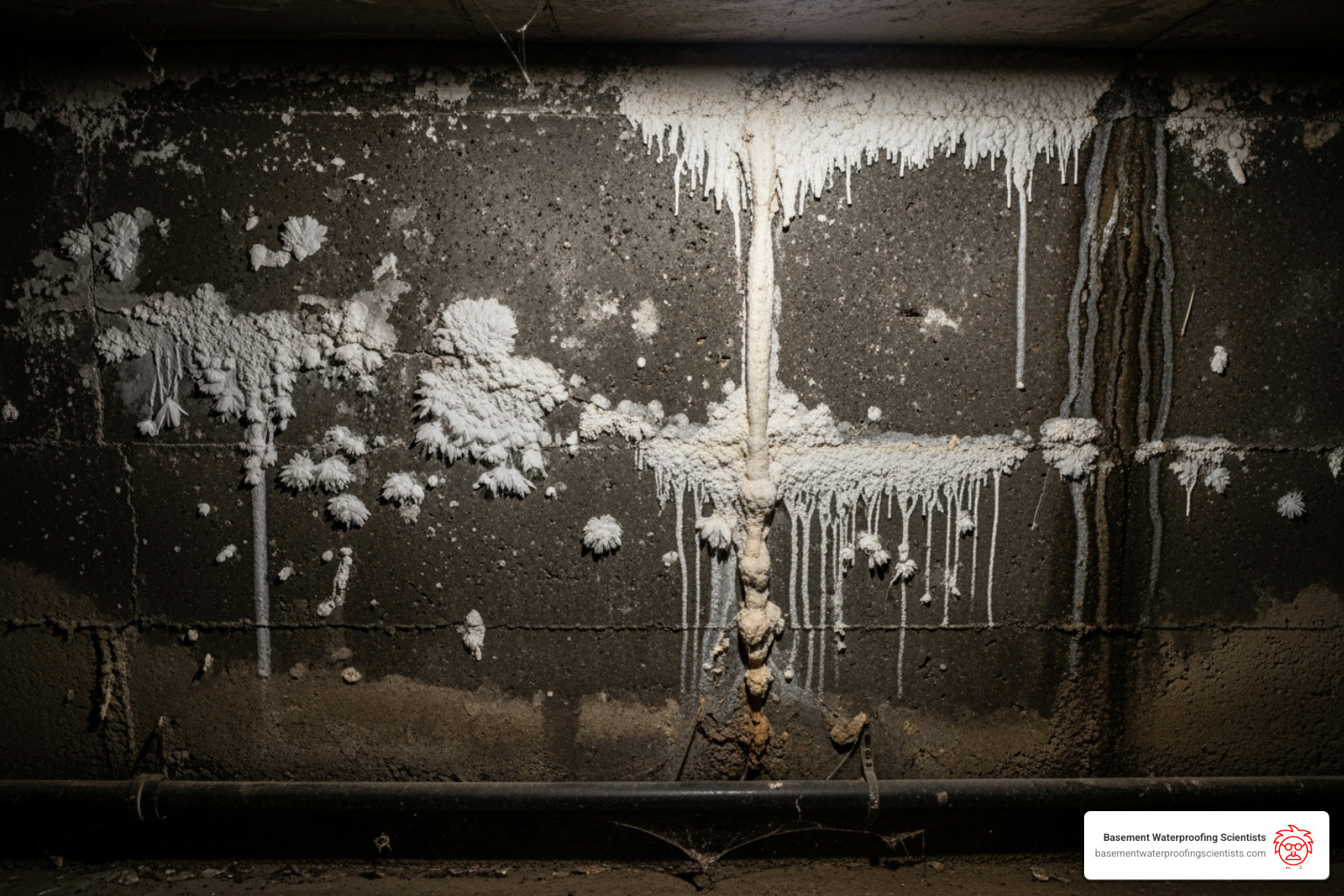
When weeping tiles get clogged, water that should flow away from your foundation backs up, causing problems. Recognizing the signs of failure early is key to preventing major damage.
Key Symptoms of a Blockage
The most obvious sign is water in your basement after rain. Any water, from a small puddle to a flood, means your drainage system needs attention and you may need to start cleaning out weeping tiles.
- Soggy soil around your foundation that stays muddy long after a storm is another red flag. Properly working tiles should whisk this water away quickly.
- Pooling water near the foundation is more serious than soggy soil. It indicates your drainage system is completely overwhelmed or blocked.
- Musty odors in the basement signal that moisture is lingering where it shouldn’t be.
- Where there’s moisture, mold and mildew will follow. Seeing fuzzy growth on walls or stored items means your drainage system is struggling.
- Peeling paint on basement walls is an early warning sign. Water seeping through concrete pushes the paint away from the surface.
- Foundation cracks can appear when hydrostatic pressure builds up, which is exactly what weeping tiles are designed to prevent. Learn more about how this affects your home in our guide on Basement Water Intrusion.
- If you have a sump pump that doesn’t run during heavy rain, it could mean water isn’t reaching the sump pit because your weeping tiles are blocked upstream.
What Causes Weeping Tiles to Clog?
- Soil and silt buildup is the most common culprit, as tiny particles gradually accumulate inside the pipes over time.
- Debris from weep holes, such as small rocks, leaves, or construction debris, can enter the system and create blockages.
- Invasive tree roots are a persistent problem. They seek out water sources and can grow rapidly inside pipes, causing complete blockages.
- Collapsed pipes are more common in older systems made of less durable materials. A collapsed section creates an immediate, serious blockage.
- Older terracotta tiles are especially vulnerable. Their less secure joints make it easier for roots and debris to enter.
- Poorly draining clay soil holds water around your foundation longer, increasing pressure on your weeping tiles and allowing fine clay particles to enter the system. For more on how soil affects drainage, visit our Drainage Tile page.
Most of these problems are solvable and many are preventable with proper maintenance.
A Step-by-Step Guide to Cleaning Out Weeping Tiles Yourself
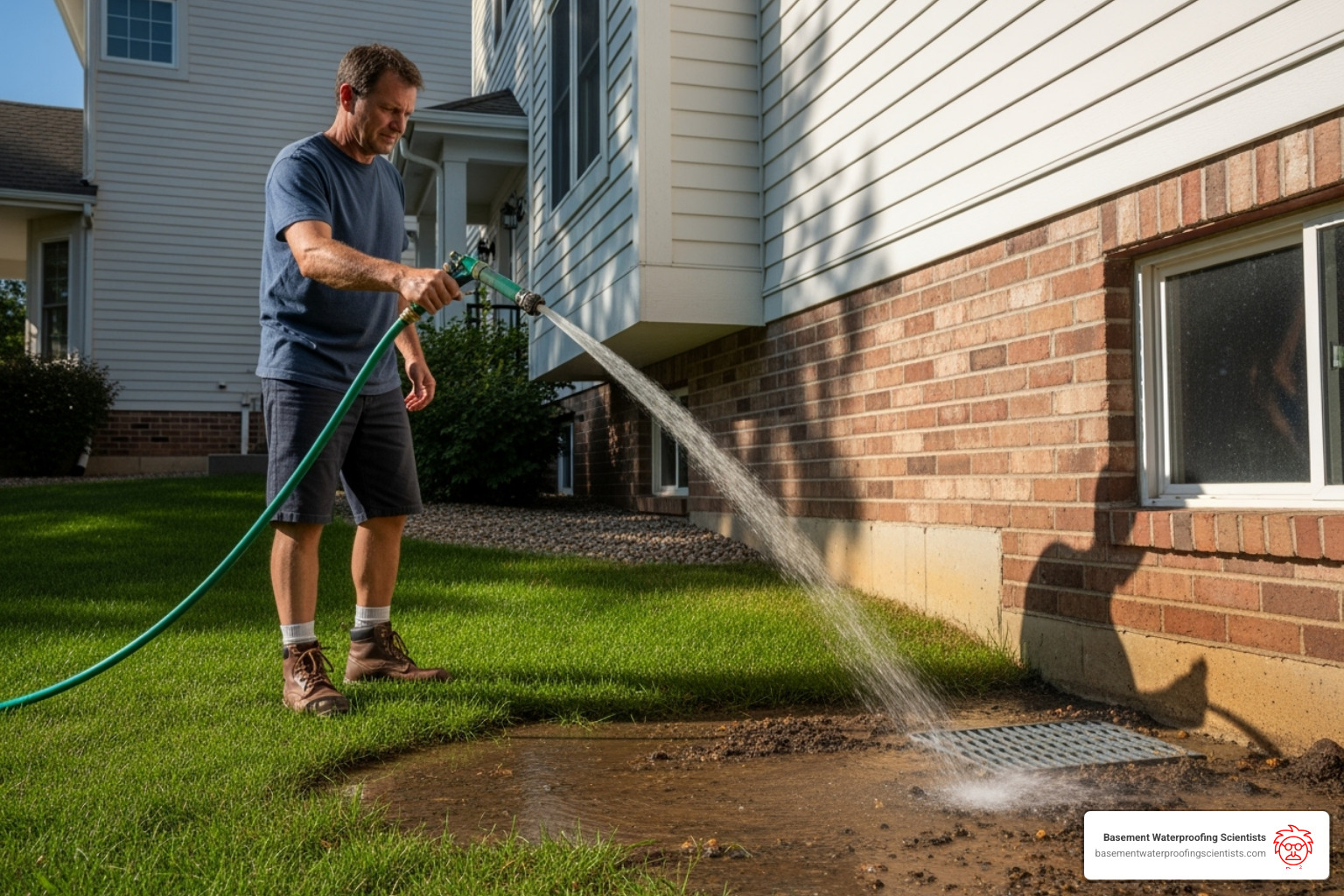
Before you start cleaning out weeping tiles, you need to confirm there’s a problem. A simple diagnostic test using a garden hose can tell you if your drainage system is working.
The Diagnostic Hose Test
This test checks your weeping tile system’s health. Start by going outside to a spot near your foundation.
Place a running garden hose directly against your foundation wall and let it saturate the soil for at least 15 to 30 minutes. If you have clay soil, you may need to wait longer. While waiting, go to your basement to observe the sump pump.
What should happen: If your weeping tiles are working, water from the hose should appear in your sump pit, and the sump pump should eventually activate to pump it out.
If nothing happens—no water in the pit, no pump action—you have a clog. The water is sitting around your foundation, just as it does during a real storm. This confirms it’s time to think about cleaning out those weeping tiles.
A Simple DIY Method for Cleaning Out Weeping Tiles
If your hose test revealed a problem, you can try this simple method before calling professionals.
Safety first: Wear rubber gloves and safety glasses, as basement work can be messy.
Find an access point to your weeping tile system, such as a floor drain, a clean-out port, or the sump pit itself.
The soapy water method can be surprisingly effective for minor blockages. Here’s how to do it:
- Connect your garden hose to a basement sink or laundry tub.
- Fill the access point with water mixed with liquid dish soap. A large plunger can help create a seal over a floor drain to direct pressure.
- Let the soapy water sit for at least 30 minutes. The soap helps break down organic matter and loosen fine silt.
- Release the water by removing the plunger or opening the clean-out. The rush of water can flush out minor debris.
- Repeat this process several times, finishing with a thorough rinse of clean water to flush out soap residue and loosened debris.
Limitations: This DIY approach is great for minor maintenance and odors but won’t solve serious blockages from tree roots, collapsed pipes, or compacted soil. If your hose test showed zero flow or water persists in your basement, you likely need professional help.
When to Call a Professional: Advanced Cleaning and Repair
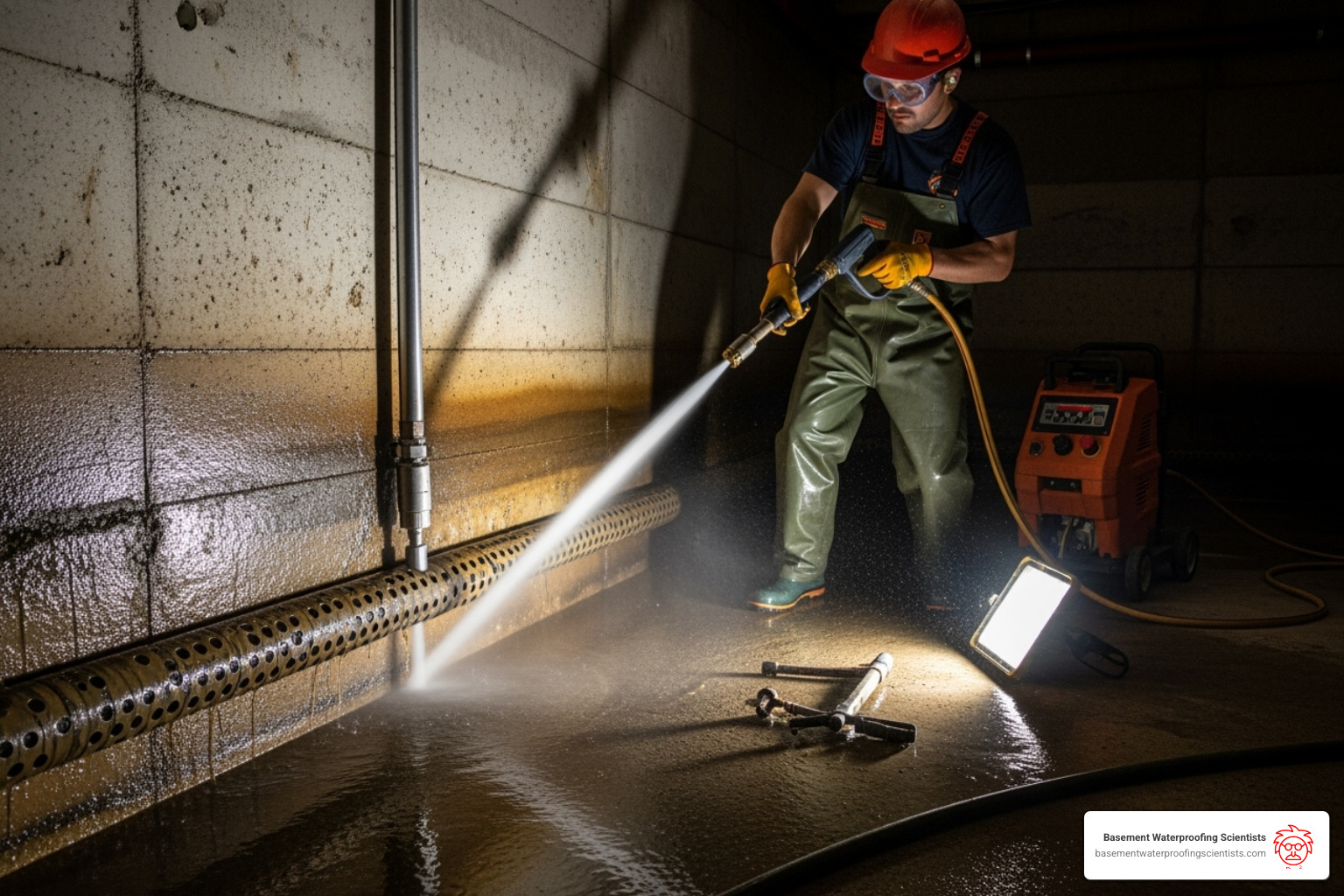
When DIY methods fail or your hose test shows no water flow, it’s time to call a professional. Expert cleaning out weeping tiles involves an accurate diagnosis and specialized tools to prevent costly water damage. Trying to force through severe blockages yourself can waste time and lead to the same wet basement.
Professional Weeping Tile Cleaning Methods
Basement waterproofing specialists use specialized equipment to tackle stubborn blockages.
- Hydro-jetting uses high-pressure water streams (thousands of PSI) to blast away everything from loose debris to compacted soil and silt, scouring pipe walls clean.
- Cable machines (augers) are used for tougher jobs, especially invasive tree roots. A flexible cable with cutting heads is fed into the pipes, spinning to chew through roots and break up solid obstructions.
- Drain camera inspection is the crucial first step. A waterproof camera is sent through the system to identify the cause and location of the clog. This determines if cleaning is sufficient or if there’s a more serious issue like a collapsed pipe. For guidance on when to call for help, see our resource on Water in Basement: Who to Call?.
[TABLE] comparing DIY vs. Professional Cleaning
| Feature | DIY Method (Soapy Water) | Professional Methods (Hydro-Jetting/Auger) |
|---|---|---|
| Best For | Minor clogs, odor neutralization, regular maintenance | Severe blockages, root intrusion, compacted debris |
| Cost | Low (cost of soap) | Moderate to High |
| Effectiveness | Limited to accessible parts of the system | Highly effective, cleans entire pipe length |
| Risk | Low risk of pipe damage | Low risk with professionals, high risk if done improperly |
| Equipment | Basic household items (plunger, hose, soap) | Specialized, expensive equipment |
Is It a Clog or a Collapse?
Sometimes a stubborn clog is actually a collapsed pipe. Signs of a collapsed pipe include persistent water problems even after professional cleaning, or camera inspection revealing cracks and breaks. This is more common in older homes (pre-1980s) with original terracotta tiles.
When cleaning isn’t enough, the only permanent solution is excavation and replacement. This involves digging up your yard to access and replace the damaged pipes. While intimidating, it’s often part of a comprehensive Foundation Repair that prevents future issues.
For extensive damage, full replacement with modern, durable plastic weeping tiles is often more cost-effective than patching. The average cost for basement waterproofing, which can include weeping tile replacement, typically ranges from $4,000 to $8,000. An accurate diagnosis from a professional is key to choosing the right, most cost-effective solution.
Weeping Tile Systems: Prevention and Key Components
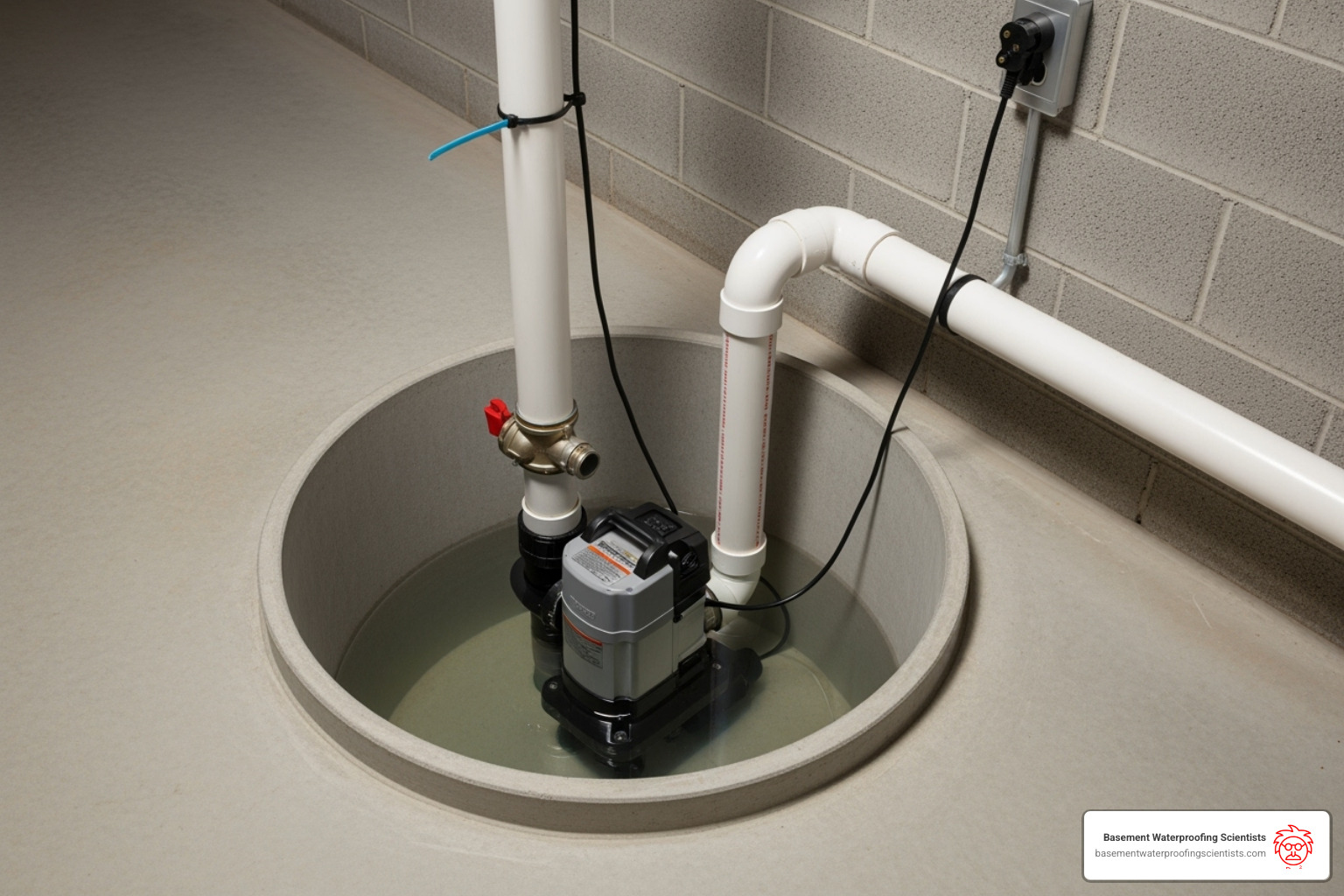
Understanding your weeping tile system’s components is key to both maintenance and prevention. Knowing how the pieces fit together is essential for cleaning out weeping tiles and preventing future problems.
Interior vs. Exterior Weeping Tile Systems
The location of your weeping tiles affects their function and maintenance.
- Exterior systems are installed outside your home’s foundation, usually during construction. They sit in a gravel-filled trench and catch groundwater before it reaches your foundation walls. However, retrofitting them is expensive and disruptive, and they are more vulnerable to tree roots.
- Interior systems are installed inside your basement, beneath the concrete floor. They capture any water that seeps through the walls or floor and direct it to the sump pump. They are less disruptive to install in existing homes and are protected from outdoor elements. Our Interior Drainage System is designed for this purpose.
How a Sump Pump Works with Your Weeping Tiles
Your sump pump and weeping tiles work as a team. The weeping tiles collect groundwater and channel it to the sump pit. When the water in the pit reaches a certain level, a float switch activates the sump pump, which pumps the water out of your basement and away from your foundation.
A functional sump pump is critical. If it fails, the pit will overflow, flooding your basement. Regular testing is essential, especially before storm season.
Backup systems are a wise investment. Battery-powered or water-powered backups can take over during a power outage, which is often when you need your pump the most. This entire setup forms a comprehensive Basement Drainage System.
How to Prevent Future Clogging in Your Weeping Tiles
Prevention can save you the headache and expense of cleaning out weeping tiles later.
- Regular Maintenance: After heavy rains, walk around your home’s perimeter. Look for soggy spots or standing water, which are early warning signs.
- Gutter Maintenance: Clogged gutters dump water right next to your foundation, overwhelming your weeping tiles. Clean them twice a year.
- Downspout Extensions: Ensure downspouts carry water at least 6-10 feet away from your foundation to reduce the load on your system.
- Proper Lot Grading: Your yard should slope away from your foundation. If water pools near your house, you may need to add soil to regrade the area.
- Clean-out Ports: When installing new weeping tiles, ask for clean-out ports. These vertical pipes provide easy access for future inspection and cleaning.
- Filter Fabric: A quality installation includes wrapping the pipes in permeable landscape fabric. This acts like a filter, letting water in while blocking soil particles that cause clogs.
Frequently Asked Questions about Weeping Tiles
Here are answers to some of the most common questions about weeping tiles.
What is the difference between a weeping tile and a French drain?
This is a common point of confusion. The weeping tile is the perforated pipe that collects water. The French drain is the entire system, which includes the trench, gravel, filter fabric, and the weeping tile pipe itself. So, a French drain contains a weeping tile. The term “French drain” is often used to describe any drainage system, adding to the confusion. For more details, see our guide on French Drain in Basement.
How often should I have my weeping tiles checked or cleaned?
There is no universal schedule for cleaning out weeping tiles. The best approach is to monitor your property.
- Check during heavy rain: This is when your system is under the most stress and problems are most apparent. Look for soggy spots or standing water near your foundation.
- Get a professional inspection every few years: This is a smart investment, especially if you have large trees, clay soil, or an older home. A drain camera inspection can spot developing issues before they cause a flood.
- Address signs of trouble immediately: Basement water problems don’t fix themselves; they only get worse and more expensive to repair.
Can I use chemical drain cleaners on my weeping tiles?
No, this is not recommended. Chemical drain cleaners are designed for household clogs like hair and grease, not the soil, silt, and roots that block weeping tiles.
- Potential for damage: Harsh chemicals can corrode plastic pipes or damage the protective filter fabric.
- Environmental concerns: Chemicals poured into your weeping tiles can end up in the groundwater or storm system, causing contamination.
- Ineffective on main culprits: Chemicals won’t dissolve tree roots or compacted soil. For these issues, you need mechanical solutions like hydro-jetting or augering, which physically remove the blockage.
Keep Your Basement Dry by Maintaining Your Weeping Tiles
Your weeping tile system is a silent guardian for your home. While it works unnoticed when functioning properly, its failure is impossible to ignore.
This guide has covered the essentials of cleaning out weeping tiles, from understanding what they are to recognizing warning signs. We’ve reviewed DIY cleaning methods and explained when to call professionals for advanced techniques like hydro-jetting.
Proactive maintenance beats reactive repairs every time. Simple steps like cleaning gutters, extending downspouts, and ensuring proper yard grading can save you thousands. It’s far easier to prevent a clog than to excavate a foundation to replace a collapsed pipe.
Neglecting your weeping tiles can lead to increased hydrostatic pressure against your foundation. This pressure can create cracks, allowing water to seep in and lead to mold, property damage, and even structural issues.
Early intervention is your best friend. If you notice soggy spots, basement water after rain, or an issue with your sump pump, don’t wait. The problem will likely worsen.
For complex issues or a professional inspection, the experts at Basement Waterproofing Scientists can use specialized equipment to diagnose the source of your water problems accurately. With 30 years of experience helping homeowners in Philadelphia, Reading, Norristown, and throughout Pennsylvania, New Jersey, and Delaware, we understand that every basement water problem is unique. Our customized solutions and lifetime guarantee ensure your basement stays permanently dry, and our specialized leak detection equipment helps us fix problems for less. Learn more about comprehensive Basement Drain Systems and how we can help protect your home.


